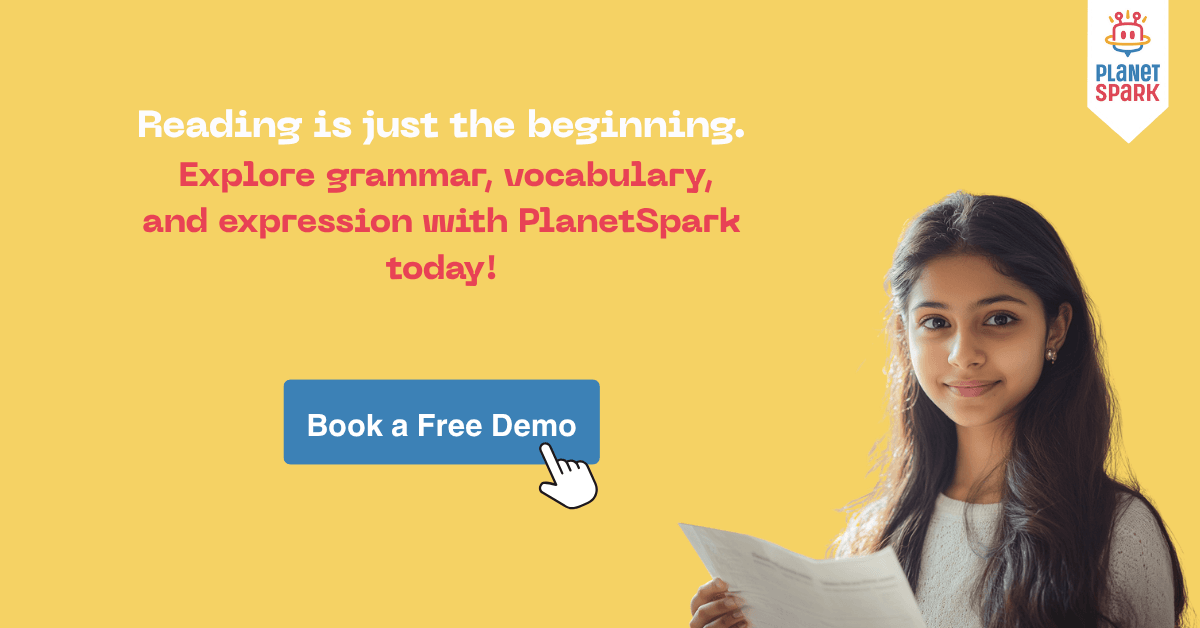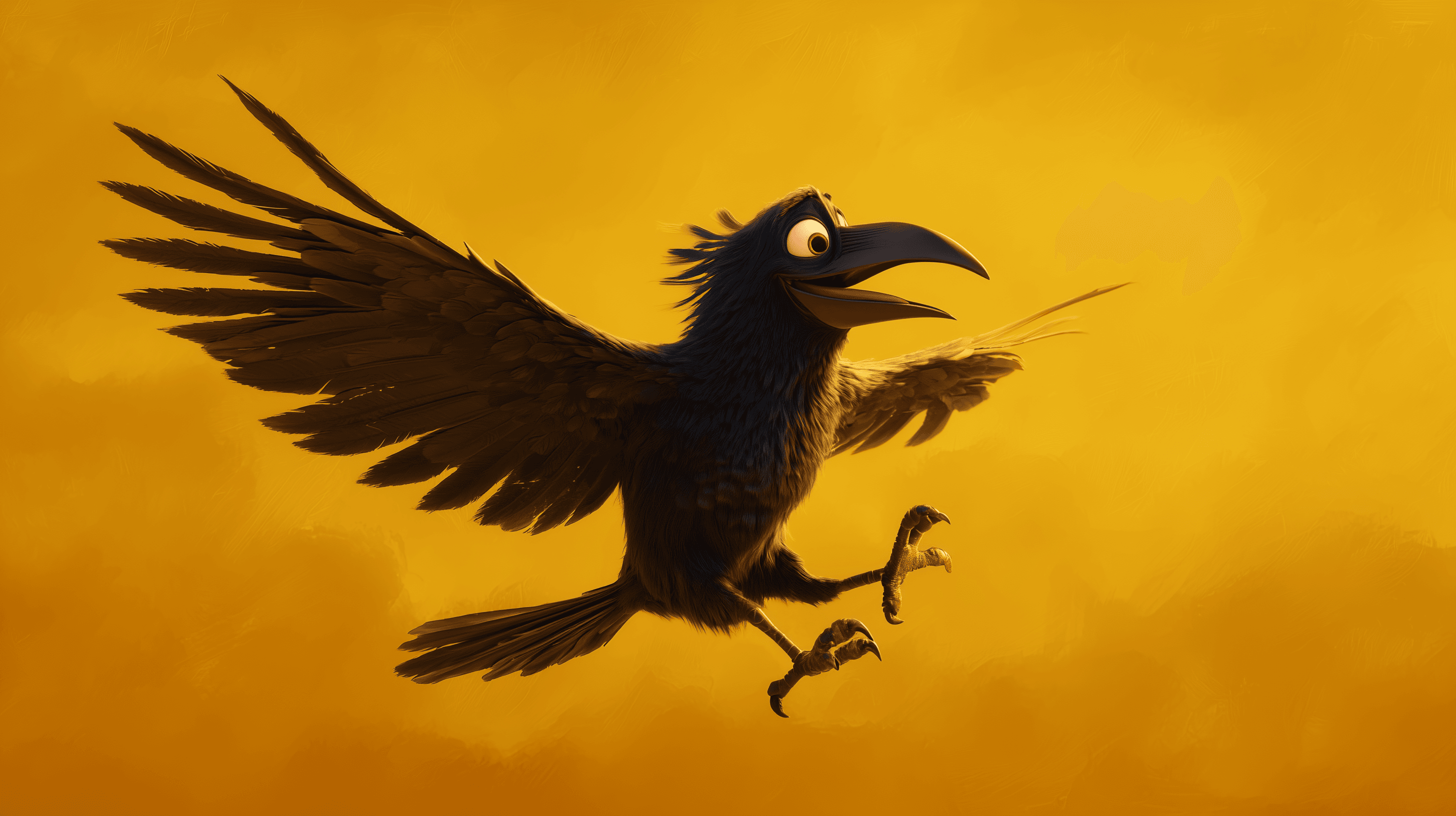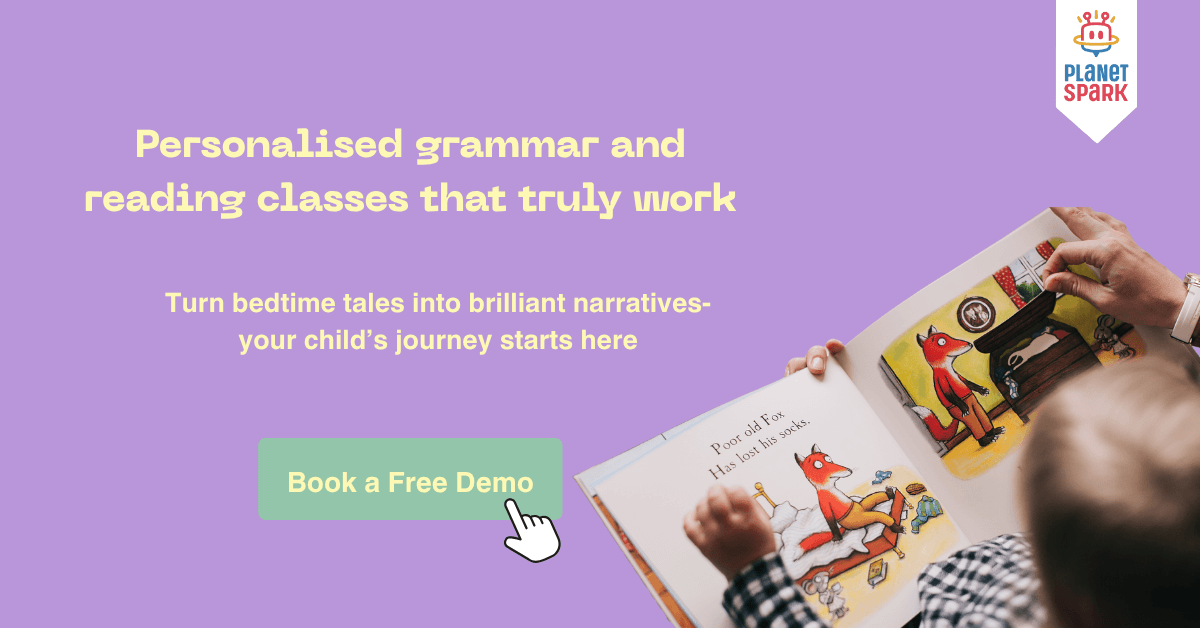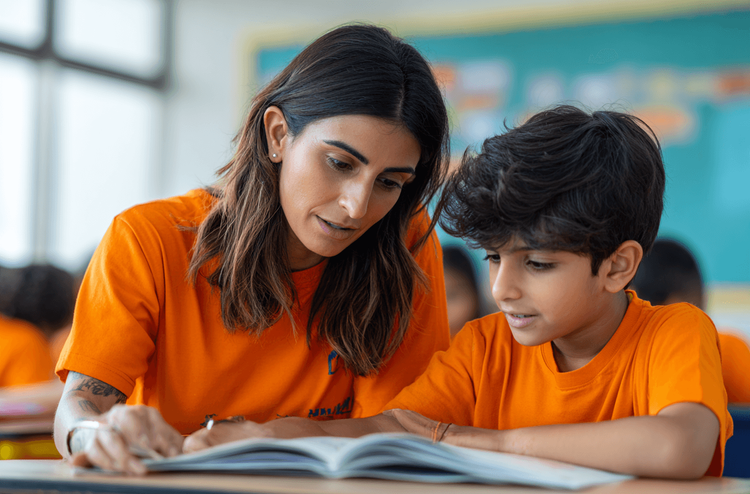For Class 4 students, this is the stage where they transition from “learning to read” to “reading to learn.” This shift makes reading comprehension skills crucial not only for academic success but also for lifelong learning.
In this comprehensive guide, we’ll dive deep into reading comprehension for Class 4 students sample passages, explain its importance & discuss strategies for improvement. Plus, we’ll show how the PlanetSpark Grammar Course supports this skill through interactive, usage-based learning.
What is Reading Comprehension?
Reading comprehension is the ability to read text, process it, and understand its meaning. It includes:
Literal comprehension (facts, details)
Inferential comprehension (reading between the lines)
Evaluative comprehension (forming judgments)
For a Class 4 student, mastering these levels allows them to interpret stories, understand nonfiction texts, follow instructions, and answer questions intelligently.

Passage 1: A Day at the Beach (Fiction)

Passage:
Last Sunday, Anaya and her family went to the beach. The sun was shining, and the sky was clear. Anaya built a huge sandcastle with towers and a moat. Her little brother splashed in the shallow water while her parents relaxed under an umbrella. They ate sandwiches, played frisbee, and collected seashells. When it was time to leave, Anaya didn’t want to go but promised to come back again.
Questions:
Where did Anaya and her family go?
What did Anaya build?
What was Anaya’s brother doing?
What did the family eat?
Did Anaya enjoy her time at the beach?
Answers:
They went to the beach.
She built a sandcastle.
He splashed in the shallow water.
They ate sandwiches.
Yes, she didn’t want to leave.
Passage 2: The Clever Crow (Fable)

Passage:
One hot afternoon, a crow was very thirsty. He searched for water everywhere. At last, he found a pitcher with little water in it. He tried to drink, but his beak couldn’t reach. The crow saw some stones nearby. He dropped the stones one by one into the pitcher. The water rose, and he happily drank it. The crow had used his clever mind to solve the problem.
Questions:
What was the crow looking for?
What problem did the crow face?
How did he solve the problem?
What happened after he added stones?
What lesson can we learn from the story?
Answers:
He was looking for water.
The water in the pitcher was too low to reach.
He put stones in the pitcher.
The water level rose.
We should use our brains to solve problems.
Passage 3: The Life of a Honeybee (Non-Fiction)

Passage:
Honeybees are important insects. They live in hives and work together. Each hive has a queen bee, worker bees, and drones. The worker bees collect nectar from flowers and turn it into honey. Bees also help plants grow by spreading pollen. Without bees, we would have fewer fruits and vegetables. So, it’s important to protect them.
Questions:
Where do honeybees live?
Name the three types of bees in a hive.
What do worker bees do?
Why are bees important for plants?
What should we do to help bees?
Answers:
They live in hives.
Queen bee, worker bees, and drones.
They collect nectar and make honey.
They spread pollen that helps plants grow.
We should protect them.
Passage 4: A Chat Between Friends (Dialogue)

Passage:
Aryan: Hi Meera! Did you finish the homework?
Meera: Yes! I did it after dinner yesterday.
Aryan: Great! I forgot we had math homework.
Meera: Don’t worry. I’ll help you. It’s about multiplication.
Aryan: Thank you! You’re a true friend.
Meera: Anytime! Let’s study together.
Questions:
Who forgot the homework?
What subject is the homework about?
When did Meera complete her homework?
What does Aryan call Meera?
How does Meera respond?
Answers:
Aryan forgot the homework.
Math (multiplication)
After dinner yesterday
A true friend
She agrees to help and study together.
From decoding stories to crafting their own your child can master it all.
Explore reading, grammar, and expression with a free, personalized demo class.
Book a free trial today!
Passage 5: The Rainbow (Poem)

Passage:
Red and yellow, green and blue,
The rainbow shows so many hues.
After rain and through the light,
It paints the sky so big and bright.
A magic bridge from ground to sky,
That fades away as clouds pass by.
Questions:
Name four colors mentioned in the poem.
When does a rainbow appear?
What does the poem compare the rainbow to?
What happens when clouds come?
What is the poem’s mood happy or sad?
Answers:
Red, yellow, green, blue
After rain, when there is light
A magic bridge
The rainbow fades
Happy
Passage 6: The Lost Puppy (Fiction)

Passage:
Neha was walking home from school when she heard a soft whimper. She looked around and saw a small brown puppy hiding behind a bush. It was cold and scared. Neha took off her jacket, wrapped the puppy in it, and took it home. Her parents agreed to take it to the vet. After a few days, the puppy felt better and wagged its tail happily. Neha named him "Buddy."
Questions:
What did Neha find behind the bush?
How did she help the puppy?
Where did her parents take the puppy?
What name did Neha give to the puppy?
How was the puppy feeling in the end?
Answers:
A small brown puppy
Wrapped it in her jacket and took it home
To the vet
Buddy
Happy and wagging its tail
Passage 7: Why Do Leaves Change Color? (Informational)

Passage:
In autumn, many trees shed their leaves. But before they fall, the leaves change color. This happens because the green pigment, called chlorophyll, breaks down. As the green fades away, yellow, orange, and red colors appear. These colors were always in the leaves, but the green was stronger before. When the days get shorter and colder, trees prepare to rest for winter.
Questions:
What season causes leaves to change color?
What pigment gives leaves their green color?
Why do other colors become visible in leaves?
What colors can we see in autumn leaves?
What are trees preparing for in winter?
Answers:
Autumn
Chlorophyll
Because green pigment fades
Yellow, orange, red
Rest
Passage 8: A Visit to the Zoo (Diary Entry)

Passage:
Dear Diary,
Today was amazing! We went to the city zoo with our class. I saw lions, elephants, giraffes, and even a red panda! My favorite part was watching the monkeys swing from tree to tree. We ate lunch near the peacock garden and took lots of pictures. I want to visit again with my family. What a fun day!
Questions:
Who went to the zoo?
Name four animals the writer saw.
What was the writer’s favorite part?
Where did they eat lunch?
What does the writer want to do again?
Answers:
The writer and their class
Lions, elephants, giraffes, red panda
Watching the monkeys swing
Near the peacock garden
Visit the zoo again with family
Passage 9: A Wise Old Man (Short Story)

Passage:
In a quiet village, there lived a wise old man. People came from far away to ask him for advice. One day, a boy came to complain that his life was full of problems. The old man gave him a teaspoon of salt and asked him to stir it into a glass of water and drink. “How does it taste?” he asked. “Very salty!” said the boy. Then he gave the boy the same salt but asked him to throw it into a lake and drink the lake water. “It tastes like plain water,” said the boy. The old man smiled and said, “Problems are like salt. If you make your world bigger, they seem smaller.”
Questions:
Where did the wise man live?
Why did people visit him?
What did the old man ask the boy to do first?
What lesson did the old man teach?
What is the story’s message?
Answers:
In a quiet village
To ask for advice
Mix salt in water and drink
Problems feel smaller in a bigger world
Change your perspective to handle problems
Passage 10: The Mysterious Footprints

Reading Passage:
It had just stopped raining when Arjun stepped into the garden. The ground was wet and muddy. As he walked toward the swing, he noticed something strange a trail of footprints that didn’t belong to him. They were small and ended behind a bush. Curious, Arjun slowly tiptoed closer. Behind the bush, he found a tiny puppy shivering in the cold. Arjun quickly picked it up, wrapped it in his scarf, and ran inside. His parents smiled and brought a towel to dry the puppy. They decided to keep it and named it "Shadow" because of how quietly it had followed Arjun home.
Comprehension Questions:
When did Arjun step into the garden?
What did Arjun notice in the mud?
Where did the footprints lead?
What did Arjun do when he saw the puppy?
Why was the puppy named “Shadow”?
Answers:
After it had stopped raining
A trail of small footprints
Behind a bush
He picked it up, wrapped it in his scarf, and took it inside
Because it had quietly followed Arjun like a shadow
Discover The Transformation Of Our Young Learners

Common Types of Texts for Class 4 Reading Comprehension
1. Fables and Short Stories
Fables and short stories are among the most engaging text types for Class 4 students. They often feature animal characters, magical elements, or relatable situations that carry clear messages.
Moral Education: These stories typically end with a moral, helping children differentiate right from wrong
Character Understanding: They introduce values such as honesty, kindness, hard work, and courage through relatable characters
Imagination and Empathy: Short stories encourage kids to imagine new worlds and step into the shoes of others, fostering empathy
Example: "The Fox and the Grapes" teaches that it’s easy to despise what we can’t have.
2. Poems
Poems introduce children to language in its most artistic form. Whether rhyming or free verse, poems expose children to a musical rhythm of words and vivid imagery.
Vocabulary Enhancement: Poems introduce new and expressive vocabulary in creative ways
Sound and Rhythm: Exposure to rhyme, alliteration, and meter helps with pronunciation and listening skills.
Emotional Awareness: Children learn to identify and understand emotions like joy, sadness, wonder, and humor through poetic expression
Example: A poem about a rainy day can spark discussions on feelings, seasons, and nature.
3. Non-fiction Articles
Non-fiction texts such as articles about animals, places, inventions, or famous people help students make real-world connections.
Builds General Knowledge: These articles introduce facts and information about the world around us
Promotes Curiosity: They often trigger questions, leading children to explore further
Develops Fact vs Opinion Skills: Children begin to differentiate between what is factual and what is imaginative or personal
Example: An article on "The Life Cycle of a Butterfly" helps children understand science through reading.
4. Instructions or Recipes
Procedural texts like step-by-step instructions, rules, or simple recipes help children develop logical and sequential thinking.
Order and Structure: These texts teach students to follow steps in a specific order
Real-Life Application: Children see how reading helps them complete real tasks (e.g., making a sandwich, setting up a game)
Attention to Detail: Following precise directions strengthens focus and comprehension
Example: A recipe for fruit salad can teach sequencing, measurements, and following written commands.
5. Dialogues and Conversations
Reading dialogues whether from a story, script, or everyday scene helps students understand practical, spoken language.
Improves Sentence Structure Understanding: Kids see how people talk in different situations using proper grammar and punctuation
Introduces Everyday Vocabulary: Dialogues often reflect real conversations shopping, greeting, asking questions which build usable language skills
Encourages Expression and Fluency: Reading dialogues aloud builds fluency and expression, vital for spoken English and public speaking
Example: A dialogue between a shopkeeper and a customer helps practice polite phrases and transactional language.

Why Reading Comprehension is Critical in Class 4
Class 4 is a turning point in a child’s academic journey. It marks the transition from basic reading to reading to learn. No longer is reading limited to language classes students now encounter text-heavy content in every subject, from science and social studies to mathematics and moral education.
This is why reading comprehension becomes a foundational skill for overall success. Let’s take a deeper look at how strong or weak comprehension impacts a child’s development:
What Happens When Reading Comprehension is Weak?
Struggles Across Subjects
Without understanding what they read, children can't solve word problems in math, grasp scientific concepts, or interpret historical events. Even instructions in exams become confusing. Weak comprehension creates academic roadblocks everywhere.Limited Vocabulary Growth
Children with poor comprehension often skip unfamiliar words or misinterpret them. As a result, they miss out on building a rich vocabulary, which is key to expressing themselves clearly in writing and speech.Loss of Interest in Reading and Learning
When reading feels like a chore or causes confusion, children may avoid it altogether. This lack of interest often spreads to other subjects, leading to low motivation, poor performance, and falling behind peers.
How Strong Comprehension Skills Make a Difference
Improves Academic Performance: A student who reads with understanding can better analyze questions, follow instructions, and recall facts. This improves performance not just in English but also in science, math, social studies, and even computer studies.
Boosts Confidence: Imagine the joy of a child who can read a story and explain it, or finish a test feeling sure of their answers. Comprehension leads to success, and success builds self-confidence in and beyond the classroom.
Enhances Critical and Analytical Thinking: Good readers don’t just understand the words they ask questions, make predictions, draw conclusions, and compare ideas. These thinking skills are essential for problem-solving in academics and real life.
Strengthens Communication Skills: Children who understand what they read tend to speak and write more effectively. They can describe events, express opinions, and explain ideas clearly skills that are crucial for presentations, group discussions, and creative writing.
How PlanetSpark Grammar Course Boosts Reading Comprehension
Why Choose PlanetSpark’s Grammar Course?
Here’s how it perfectly supports Class 4 reading development:
| Feature | Benefit for Reading Comprehension |
|---|---|
| Usage-Based Grammar | Helps children connect grammar to real sentences |
| Interactive Stories & Dialogues | Makes grammar and comprehension feel natural |
| Error Correction in Real-Time | Improves sentence understanding instantly |
| Writing Tasks Linked to Grammar | Reinforces comprehension through writing |
| Gamified Learning Tools | Retains grammar concepts longer, helps sentence decoding |
| Concept to Application Model | Builds step-by-step fluency in understanding text |
| Structured Proficiency Levels | Matches students' growth with increasing text complexity |
| Parent Reports | Measure real improvements in comprehension and writing fluency |
PlanetSpark's Role in Strengthening Comprehension
Through its Grammar and English courses, PlanetSpark helps children:
Understand sentence structure and grammar, which is key to decoding meaning
Expand their vocabulary in context
Practice reading through stories, dialogues, and comprehension worksheets
Develop confidence in reading, writing, and speaking
With the right tools and guidance, every child can become an active, curious, and confident reader.
Give your child the confidence to master reading.
Enroll in a FREE TRIAL Grammar Class at PlanetSpark today!
Conclusion
Reading comprehension is not just a school subject it’s a core life skill. For Class 4 students, developing strong comprehension lays the foundation for academic success, better communication, and confident expression.
With the right strategies, engaging practice, and expert guidance like the PlanetSpark Grammar Course your child can become a thoughtful and fluent reader.
Frequently Asked Questions: Reading Comprehension for Class 4
Q1. What is reading comprehension for Class 4 students?
A: Reading comprehension is the ability to read a passage, understand its meaning, and answer questions based on the text. For Class 4, it includes understanding main ideas, details, sequence of events, and making inferences.
Q2. Why is reading comprehension important in Class 4?
A: At this level, children begin reading across subjects like science, math, and social studies. Strong comprehension skills help them understand concepts, follow instructions, and perform better in academics.
Q3. How can I help my child improve reading comprehension at home?
A: Encourage regular reading, ask questions about the story, practice summarizing, and introduce age-appropriate passages. Use tools like story maps, reading journals, and discussions to deepen understanding.
Q4. What types of questions are asked in reading comprehension exercises?
A: Questions typically include multiple choice, true/false, short answers, vocabulary-based, sequencing, and inference questions. These assess how well the child understands the passage.
Q5. How often should my child practice reading comprehension?
A: Daily or at least 3–4 times a week is ideal. Short, consistent practice sessions are more effective than long, infrequent ones. The key is regular exposure to different types of texts.


